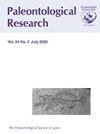Death or Living Assemblage? The Middle Permian Discinid Brachiopods in the Kamiyasse Area, Southern Kitakami Mountains, Northeastern Japan
IF 0.6
4区 地球科学
Q3 PALEONTOLOGY
引用次数: 1
Abstract
Abstract. Linguliformean brachiopods often exhibit a clustered occurrence. Because there has been no detailed analysis of whether these clusters represent death or living assemblages, we exemplified the burial processes of the Middle Permian discinid brachiopods from the Hoso-o Formation with the systematic descriptions of Orbiculoidea verum sp. nov. and Discinidae gen. et sp. indet. There were three types of discinid occurrences: 1) articulated Orbiculoidea in a ventral-side-down orientation, 2) disarticulated valves of both species in a convex-up orientation, and 3) disarticulated ventral valves of the Orbiculoidea in a convex-down orientation. The articulated specimens occurred in laminated mudstone and must have been autochthonous, while the disarticulated specimens with a convex-up orientation were para-autochthonous, resulting from turbiditic or storm flow. The specimens with convex-down ventral valves always occurred at the base of the sandstone beds with their ventral apexes slightly penetrating the underlying mudstone. This is the argument for an autochthonous ventral valve, whereby only the dorsal valve was transported after death. The distribution of epibionts suggests that the life posture of the Orbiculoidea was a ventral-side-down orientation, with its anterior half slightly higher than the sediment-water interface, which was advantageous for the feeding flow and the clearance of sediments around the posterior margin. Although dense monospecific assemblages of Orbiculoidea occur only as disarticulated valves, the exclusive occurrence of articulated individuals in the underlying mudstone suggest that the animal inhabited the specific environments opportunistically, which has never been explored in other fossilised organisms.死亡还是活着的组合?日本东北部北上山南部Kamiyasse地区二叠纪中期盘状腕足类
摘要林古利形目腕足类动物经常出现集群。由于还没有详细分析这些集群是代表死亡还是活的组合,我们通过对Orbiculoidea verum sp.nov.和Discinidae gen.et sp.indet的系统描述,举例说明了Hoso-o组中二叠纪盘状腕足类的埋葬过程。椎间盘状突起有三种类型:1)腹侧朝下的有关节Orbiculoide,2)两个物种的瓣叶均呈凸向上的无关节,3)腹侧瓣叶呈凸向下的无关节。铰接标本出现在层状泥岩中,一定是本地的,而凸起向上的非铰接标本是准本地的,由浊积流或风暴流引起。腹瓣向下凸起的标本通常出现在砂岩层的底部,其腹尖略穿透下伏的泥岩。这就是本地腹侧瓣膜的论点,即死亡后只有背侧瓣膜被运输。表生生物的分布表明,Orbiculoide的生活姿态是腹侧向下的,其前半部分略高于沉积物-水界面,这有利于进食流和清除后缘周围的沉积物。尽管密集的单特异性Orbiculidea组合仅以无关节瓣膜的形式出现,但在下层泥岩中只出现有关节个体,这表明该动物是机会主义地生活在特定环境中,而在其他化石生物中从未探索过这一点。
本文章由计算机程序翻译,如有差异,请以英文原文为准。
求助全文
约1分钟内获得全文
求助全文
来源期刊

Paleontological Research
PALEONTOLOGY-
CiteScore
1.60
自引率
0.00%
发文量
47
审稿时长
>12 weeks
期刊介绍:
Paleonotological Research (PR) is a quarterly, peer-reviewed international journal, which focuses on original contributions primarily in the area of paleontology but also covering a wide range of allied sciences. It has been published since 1997 as a successor to the former journal Transactions and Proceedings of the Palaeontological Society of Japan. The emphasis of contributions will include global and local perspectives, and contents can cover all ages (Precambrian to the Quaternary, including the present time).
 求助内容:
求助内容: 应助结果提醒方式:
应助结果提醒方式:


